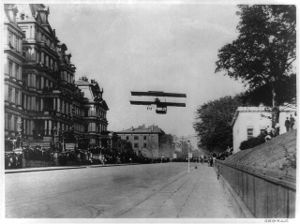Farman III
| Farman III | |
|---|---|

|
|
| Type: | Pusher propeller - double decker |
| Design country: | |
| Manufacturer: | |
| First flight: |
April 6, 1909 |
The Farman III was an early biplane of Henri Farman from the year 1909th
Construction history
The Farman III was the first machine that Henri Farman manufactured in his newly established aircraft factory. Farman was originally a customer of Aéroplanes G. Voisin , whose machines he modified into racing planes. In 1909 Farman fell out with the owner Gabriel Voisin because he had sold the Voisin Farman II he had ordered to the British John Cuthbert Moore-Brabazon .
Farman built a completely redesigned machine with ailerons , which were already integrated into the wings as movable elements (see picture). The machine first flew on April 6, 1909 and proved to be extremely easy to fly. Farman decided to take part in the flight week in Reims from August 22 to August 29, 1909 with the new aircraft .
Flight week in Reims 1909
During the flight week in Reims in 1909 , Farman replaced the unreliable 50 HP Vivinus four-cylinder in-line engine with the modern Gnôme 7-cylinder rotary engine of the same power. The flight week was a great success for Farman by winning a number of prizes:
- 1st prize distance flight over 180 km
- 1st price for a flight with two passengers
- 2nd prize for a high altitude flight of 110 m
Other uses

In 1910 Farman revised the Type III. He increased the dimensions and replaced the engine with a 60 hp ENV engine .
Louis Paulhan traveled to the USA with two Farman IIIs to demonstrate the machine. At the Dominguez International Air Meet in Los Angeles from January 10 to 20, 1910, he became the great flying star. The Americans were enthusiastic about the spectacular flight maneuvers. He set a new altitude record with 1269 m and a long-term flight record with 1 hour and 49 minutes.
Paulhan also took American publisher William Randolph Hearst on his first flight. For the US Army, bombing attempts were carried out with dummy bombs by the passenger Lieutenant Paul Beck.
From April 27 to 28, 1910, the next flight race from London to Manchester took place. The 294 km race made the two Farman III drivers Claude Grahame-White and Louis Paulhan world famous. Louis Paulhan was the winner, receiving the Daily Mail Donated Prize of £ 10,000.
From May 1910, Simon Brunnhuber trained the first German military pilots at the Döberitz airfield with a Farman III imported by Walther Huth . Since the flights in 1910 were accident-free, the aircraft, initially given to the military free of charge, was purchased on December 18, 1910 as the first German military aircraft with the army designation "B 1".
In June 1910, Lieutenant Savoia flew in stages from Mourmelon to Centocelle airfield near Rome.
On October 14, 1910 there was a spectacular flight in Washington, DC by Claude Grahame White, who made a flight over W. Executive Avenue.
First war mission in Libya in 1911
Some Farman IIIs were sold to Italy, where the army put together the first flight unit in aviation history. The first war mission was in the Italo-Turkish War in Libya at the end of 1911. The Farman III was used here for photo reconnaissance.
Replicas
The Farman III was used and modified in several countries. The best-known models were the Bristol Boxkite and the German "Albatros-Farman" replicas made by Albatros Flugzeugwerke .
The Russian army also used Farman III on a small scale. Its successor, the Farman IV , was used for training on a large scale.
A flyable replica of the Farman III is in the Flying Museum in Grossenhain.
Technical specifications
| Parameter | Data |
|---|---|
| crew | 1 |
| Passengers | 1-2 |
| length | 12 m |
| span | 10.5 m |
| height | 3.50 m |
| Wing area | 38 m² |
| Empty mass | 400 kg |
| Takeoff mass | 550 kg |
| Top speed | 60 km / h |
| Range | 180 km |
| Engine | a Gnôme 7-cylinder rotary engine with 50 HP (37 kW) |
literature
- Christopher Chant: Austro-Hungarian Aces of World War I , Osprey Publishing
Individual evidence
- ↑ Günter Schmitt: When the oldtimers flew - The history of the Johannisthal airfield . Transpress, Berlin 1980, ISBN 3-344-00129-9 . , P. 160
Web links
- Flying Museum
- Hill Aerospace Museum: Louis Paulhan ( February 10, 2007 memento on the Internet Archive ), accessed April 27, 2017
- www.militarymuseum.org Dominguez International Air Meet
- Flight week from Reims 1909 (English)
- EADS, History of Motorized Flight 1900–1909 ( Memento of February 8, 2007 in the Internet Archive ): Farman III, accessed on March 17, 2009
- The Farman III of the MHM Berlin-Gatow on Museum Digital

